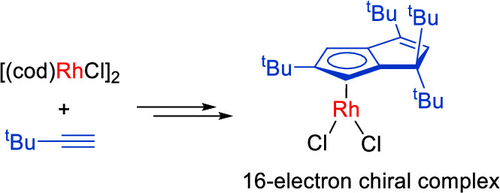当前位置:
X-MOL 学术
›
Organometallics
›
论文详情
Our official English website, www.x-mol.net, welcomes your
feedback! (Note: you will need to create a separate account there.)
Synthesis of Overloaded Cyclopentadienyl Rhodium(III) Complexes via Cyclotetramerization of tert-Butylacetylene
Organometallics ( IF 2.5 ) Pub Date : 2021-09-02 , DOI: 10.1021/acs.organomet.1c00403 Andrey V. Kolos 1 , Yulia V. Nelyubina 1 , Basker Sundararaju 2 , Dmitry S. Perekalin 1, 3
Organometallics ( IF 2.5 ) Pub Date : 2021-09-02 , DOI: 10.1021/acs.organomet.1c00403 Andrey V. Kolos 1 , Yulia V. Nelyubina 1 , Basker Sundararaju 2 , Dmitry S. Perekalin 1, 3
Affiliation

|
Herein we describe the synthesis and reactivity of rhodium catalysts with the very bulky cyclopentadienyl ligand C8H3tBu4 (designated as tBu4Cp). The reaction of [Rh(cod)Cl]2 with tert-butylacetylene in the presence of Et3N gives the complex (tBu4Cp)Rh(cod) (60–65% yield), in which the cyclopentadienyl ligand tBu4Cp is assembled from four alkyne molecules. The oxidation of (tBu4Cp)Rh(cod) with chlorine or bromine gives the corresponding halide complexes (tBu4Cp)RhX2 (X = Cl (85%), Br (95%)), which have unusual 16-electron monomeric structures due to the steric shielding provided by tBu groups. A similar reaction with iodine gives the ionic dinuclear complex [(tBu4Cp)RhI3Rh(tBu4Cp)]I (99%) with halide bridges. The bromide complex (tBu4Cp)RhBr2 reacts with phosphorus ligands such as P(OMe)3, P(OPh)3, PMe2Ph, and PMePh2 to give the 18-electron adducts (tBu4Cp)RhBr2(PR3), but no reaction occurs with larger phosphines such as PPh3. The racemic chloride (tBu4Cp)RhCl2 can be separated into enantiomers by preparative TLC of its diastereomeric adducts with (R)-phenylglycinol. The complex (tBu4Cp)RhBr2 catalyzes C–H activation and annulation of O-pivaloyl-hydroxamate as well as insertion of phenyldiazoacetate into E–H bonds, although the reaction rates and the substrate scope are limited by the bulky tBu4Cp ligand.
中文翻译:

叔丁基乙炔环四聚反应合成重载环戊二烯铑(III)配合物
在此,我们描述了铑催化剂与非常庞大的环戊二烯基配体 C 8 H 3 t Bu 4(指定为t Bu 4 Cp)的合成和反应性。[Rh(cod)Cl] 2与叔丁基乙炔在 Et 3 N存在下反应生成配合物 ( t Bu 4 Cp)Rh(cod)(60–65% 产率),其中环戊二烯基配体t Bu 4 Cp 由四个炔分子组装而成。( t Bu 4 Cp)Rh(cod) 用氯或溴氧化得到相应的卤化物配合物(t Bu 4 Cp)RhX 2 (X = Cl (85%), Br (95%)),由于t Bu 基团提供的空间屏蔽,它们具有不寻常的 16 电子单体结构。与碘的类似反应产生具有卤化物桥的离子双核络合物 [( t Bu 4 Cp)RhI 3 Rh( t Bu 4 Cp)]I (99%)。溴化物络合物 ( t Bu 4 Cp)RhBr 2与磷配体如 P(OMe) 3、P(OPh) 3、PMe 2 Ph 和 PMePh 2反应生成 18 电子加合物 ( t Bu4 Cp)RhBr 2 (PR 3 ),但与较大的膦(如 PPh 3)不发生反应。外消旋氯化物 ( t Bu 4 Cp)RhCl 2可通过其与 ( R )-苯基甘氨醇的非对映加合物的制备型 TLC 分离为对映异构体。络合物(吨卜4的Cp)RhBr 2催化C-H活化和的环ö -pivaloyl异羟肟酸酯以及phenyldiazoacetate插入E-H键,尽管反应速率和衬底范围由笨重的限制吨卜4 Cp 配体。
更新日期:2021-09-02
中文翻译:

叔丁基乙炔环四聚反应合成重载环戊二烯铑(III)配合物
在此,我们描述了铑催化剂与非常庞大的环戊二烯基配体 C 8 H 3 t Bu 4(指定为t Bu 4 Cp)的合成和反应性。[Rh(cod)Cl] 2与叔丁基乙炔在 Et 3 N存在下反应生成配合物 ( t Bu 4 Cp)Rh(cod)(60–65% 产率),其中环戊二烯基配体t Bu 4 Cp 由四个炔分子组装而成。( t Bu 4 Cp)Rh(cod) 用氯或溴氧化得到相应的卤化物配合物(t Bu 4 Cp)RhX 2 (X = Cl (85%), Br (95%)),由于t Bu 基团提供的空间屏蔽,它们具有不寻常的 16 电子单体结构。与碘的类似反应产生具有卤化物桥的离子双核络合物 [( t Bu 4 Cp)RhI 3 Rh( t Bu 4 Cp)]I (99%)。溴化物络合物 ( t Bu 4 Cp)RhBr 2与磷配体如 P(OMe) 3、P(OPh) 3、PMe 2 Ph 和 PMePh 2反应生成 18 电子加合物 ( t Bu4 Cp)RhBr 2 (PR 3 ),但与较大的膦(如 PPh 3)不发生反应。外消旋氯化物 ( t Bu 4 Cp)RhCl 2可通过其与 ( R )-苯基甘氨醇的非对映加合物的制备型 TLC 分离为对映异构体。络合物(吨卜4的Cp)RhBr 2催化C-H活化和的环ö -pivaloyl异羟肟酸酯以及phenyldiazoacetate插入E-H键,尽管反应速率和衬底范围由笨重的限制吨卜4 Cp 配体。











































 京公网安备 11010802027423号
京公网安备 11010802027423号